There are a lot of AR-15 parts that get overlooked when you start to try and boost the rifle’s performance. One of these overlooked parts is the safety selector. For most, the safety is “just there.” The design works and depending on your situation, the basic AR-15 safety is all you have to work with.
But there are a number of safety selector upgrades on the market that will make a difference when it comes to shooting. Whether that is in competition, self-defense, or other high stress environments.
Let’s go over the many aspects of safety selectors and what you should consider when upgrading your selector.
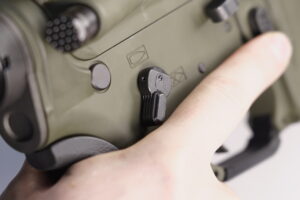
Safety Selector Overview
Safety selectors are an important party of the AR-15 platform. They allow us to carry the rifle loaded in a way that doesn’t needlessly endanger us or other people. Activating and deactivating the safety is an intrinsic part of handling the AR-15 and there are many advantages from improving that safety design.
To understand what we’re working with, we are going to go over the basic selector style and then some of the other variations.
Standard Selectors
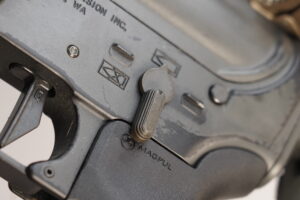
The safety selector that is going to come with your basic AR-15 has been in use since the first officially adopted M16s and hasn’t changed much from that time. The selector is horizontal (pointing towards the shooter) when on safe and then swings down 90 degrees to deactivate the safety.
Some would argue that since the design hasn’t changed since the early 1960s that it is proof of a great design. However if you are left handed or find yourself having to shoot from your left side, it is very clear that the safety selector is made for right handed people shooting from normal positions.
Here are some pros and cons for the standard selector.
Pros:
Your standard selector is very affordable, comes with almost every off-the-shelf AR-15, and is the most common type to be trained on. It creates the basic skills you’ll need to get the benefit from and appreciate selector upgrades.
Cons:
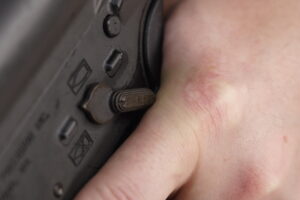
Shooting left handed, under or around barriers, and in other dynamic/awkward shooting positions will show that the standard selector is not a well rounded design. It tends to dig into the left hand when using a high grip and requires breaking that grip in order to activate it and deactivate it.
Let’s look at some of the upgrades for your selector and how they modify the performance from the standard selector.
Upgrades to Your Selector
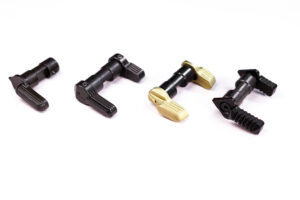
Selector upgrades will deal with three different modifications: the “throw” of the selector, the length of the selector levers, and whether or not the selector is ambidextrous.
Selector Throw
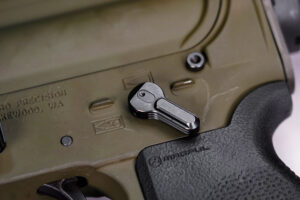
The selector’s throw is something that a lot of higher speed shooters tend to modify. Using a selector with a different lever throw angle means that instead of having to be put to 90 degrees, the selector will have to be put to a different angle.
This angle tends to be anywhere from 45-60 degrees, which makes it easier to deactivate. It also helps with select-fire guns since it takes less effort to switch to full-auto/burst than on a standard selector.
Changing your selector’s throw angle makes it easier to use, speeding up taking the gun off safe, which can impact your performance on the clock.
Pros:
Having a shorter throw for your selector makes it faster to deactivate. It also makes it more comfortable since it keeps the selector from going under your knuckle depending on your dominant hand and selector set up.
Cons:
The shorter throw also makes it easier for the safety to be accidentally deactivated. Normal 90 degree throw selectors can accidentally be swept off while moving, especially when the rifle is slung against the body. The shorter throw means there’s less “wiggle room” for that safety before it is deactivated.
Selector Lever Length
Some people prefer to have a shorter selector lever on a rifle. This is because the normal selector lever length usually puts it right under your first knuckle when using a left handed grip. The selector can dig into your hand because of this, creating a less than comfortable experience.
While this might not matter in the short term, it matters in the long term, especially if you are doing thousands of repetitions. Using a shorter selector lever makes it less likely for that selector to be jammed into your knuckle.
Shorter selector levers are usually found on guns with ambidextrous safeties or rifles set up for left handed shooters.
Pros:
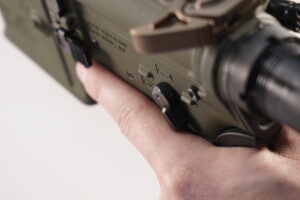
A shorter lever can be ideal on a left handed or ambidextrous rifle. A short lever keeps the selector from rubbing on your hand (unless you have absolutely enormous hands) making for a more comfortable time while shooting. This makes it easier to maintain a high grip on the rifle for better control
Cons:
If you have smaller hands or shorter fingers/thumbs a short lever is going to be harder to activate. You might have to break your grip in order to reach the lever, defeating the purpose of upgrading your rifle’s selector.
Ambidextrous Selector
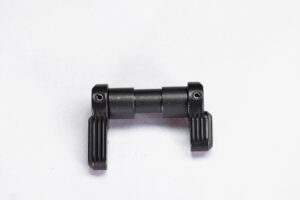
The most useful upgrade to your selector is making it ambidextrous. This makes it so you can use the selector normally from either shoulder and almost any shooting position.
Having an ambidextrous safety means you will be using the same movements with either hand without having to break your grip on the rifle. This makes for more consistent movements and more efficient movements. Which all adds up when you are pushing for those extra seconds.
Ambidextrous selectors also make the AR-15 more accessible for left-handed shooters and are more tactically sound for your dynamic environments. The less difference between how you use the rifle with your strong side compared to your weak side, the better your performance will be.
Pros:
Your rifle is now easier to use with either hand which makes it more versatile depending on the situation you find yourself shooting in. And it is better for left handed shooters, whether shooting left handed because that is your dominant side or you’re if you’re cross eye dominant.
Cons:
The only major drawback to an ambidextrous safety selector is that there is another set of controls you have to worry about rubbing up against your equipment. No matter which side of the rifle is against you, there is a lever that turns the safety off and you have to be aware of it.
Other Considerations
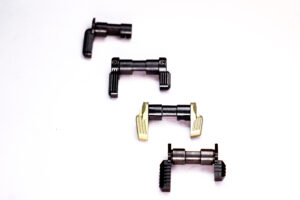
Some other factors to consider for your safety selector are what materials the selector is made of, what type of pattern is added for grip texturing, and the method of securing the levers.
Selector Materials
Selector paddles are made out of metal and are usually made from aluminum or steel.
Aluminum
Using aluminum for the safety selector helps cut down on weight throughout the entire system. However aluminum is not as durable as other options. This is because it is prone to gouging and scraping from bumping into things or being dropped.
Steel
Some selector paddles are made out of steel. This makes them more durable to abuse and sharp impacts. It is harder to shear steel than to shear aluminum. This allows steel parts to take heavier impacts and more repetitions before wearing out.
Texture Pattern
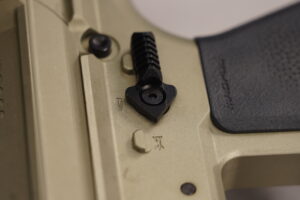
The texture on your selector is not something you would normally think about, but over time you’ll probably encounter your thumb or finger slipping or scraping on your selector. This usually is related to your hands being sweaty or slick for one reason or another.
A lot of companies will add a really cool looking texture to their selectors and most of these patterns end up working against you while your finger is interacting with the selector. The wrong pattern can cause extra friction leading to hot spots and blisters with repeated use.
The best texture patterns will be comfortable during use and aid in mitigating the chances of your thumb or finger slipping off the selector. Additionally it will provide a more positive activation/deactivation of the selector.
Selector Securing Methods
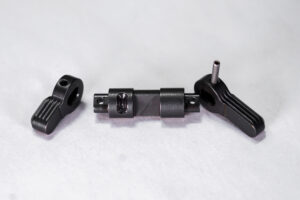
While there are several unique ways the paddles are attached, one of the most common methods is with a screw. This is a good method, especially if you add a threadlocker to prevent the screw from backing out and if you use a high quality screw that will not shear.
A less common method of securing the paddles is by using a pin that is pressed into place. This greatly reduces the chance of anything coming loose because the material is pressed into the available space creating less wiggle room for the pin.
Selector Machining
While the machining on your selector is not something you would normally think about, how the surfaces are machined plays a critical role in the smoothness of operation, how the clicks in the positioning feel, and how the paddles feel.
Simply put, a very smooth and even machined surface, free from any rough machining marks and burrs, creates the ideal surface for the detent to ride on internally and greatly helps the feel of the paddles. This small detail really aids in the overall experience.
Certain selectors can have sharp uncomfortable spots that can be irritating on your thumb. This is most commonly found when hard angles are used as well as when the surfaces are not rounded. Precise machining helps mitigate these irritation points.
Type of finish
The types of finish vary greatly depending on the material used. Regardless if you are using steel or aluminum, it’s best to keep an eye out to see if the finish is applied well. A good finish application will make the surface harder and more resistant to scratches/wear. The finish also helps steel by minimizing rust from humid environments, sweat, and oils from your body.
Guntology’s preferred AR 15 safety selector
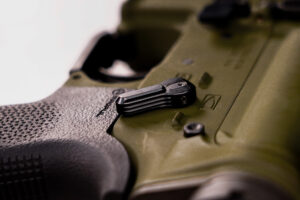
Upgrading your selector will help you with speed, consistency, and comfort when using your AR-15. Which modification or combination of modifications you choose is up to you. There are numerous options out there for everyone.
Here at Guntology, we have our own preferences. If we’re upgrading our selector, we’re going all the way. That’s why we choose the Forward Controls ASF-50. This selector is ambidextrous, has both long and short throw levers, and has a 50 degree throw.
The fit and finish is amazing. The smooth machining combined with the black nitride finish makes the ASF-50 look and feel smooth. From the feel against your thumb or finger to the positive clicks during use, this option can only be fully appreciated through experience.
Forward Controls went the extra mile by using serrations instead of their All Angles texturing. This was because serrations facilitate the motion of putting the safety on and off. Combine this with the use of a roll pin to secure the lever and you have a reliable ambidextrous selector.
The ASF-50 is in our opinion the ideal safety selector on the market.The reason for this opinion is just how much Forward Controls put into their products. The ASF-50 could be like any other selector and be made out of aluminum. Instead they use a 420 stainless spring steel with a higher shear strength in order to maintain the integrity of the selector.
Applying a series of serrations on the paddles creates the perfect environment for your thumb to activate the selector while not slipping off. The installation is simple and more secure than other ambidextrous safety solutions. The finish and materials combine for long term reliability. That extra attention to detail goes into all of their products and is why we put it on our rifles.
